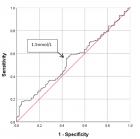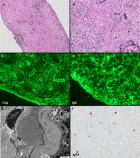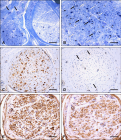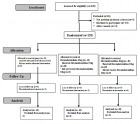Abstract
Research Article
The role of urine metabolomics among newborn infants with hypoxic ishaemic encephalopathy: a literature review
Nese Gadzama*, Irfan Ahmed, Sundus Khursheed, Niazy AL-Assaf and Rizwan Khan
Published: 09 November, 2021 | Volume 4 - Issue 1 | Pages: 109-113
Background: Perinatal asphyxia (PA) which may result in hypoxic ischaemic encephalopathy (HIE) affects four million neonates worldwide and accounts for the death of one million of affected babies. The science of metabolomics has become an area of growing interest in neonatal research, with a potential role in identifying useful biomarkers that can accurately predict injury severity in perinatal asphyxia and HIE.
The aim of this review is to look at the evidence of the usefulness of urine metabolomics in predicting outcome in PA/HIE.
Methods: The key words used in the advanced search ‘urine metabolomics’ AND ‘perinatal asphyxia’ OR ‘hypoxic ischaemic encephalopathy’, yielded 13 articles.
Results: Of the selected thirteen studies, 38% (n = 5) were human studies, 31% (n = 4) were animal studies and 31% (n = 4) were review articles. The studies confirmed the involvement of known pathways in the development of PA/HIE, primarily the Krebs cycle evidenced by accumulation of TCA cycle intermediates (citrate, α-ketoglutarate, succinate) and anaerobic pathways indicated by increased lactate. Other pathways involved include amino acid and carbohydrate pathways.
Conclusion: Metabolomic studies so far are promising in highlighting potential biomarker profiles in PA/HIE. Further research is necessary to further clarify the role of identified metabolites in predicting outcome and prognosis in neonates affected by PA/HIE.
Read Full Article HTML DOI: 10.29328/journal.japch.1001042 Cite this Article Read Full Article PDF
Keywords:
Urine metabolomics; Biomarker; Perinatal asphyxia; Hypoxic ischaemic encephalopathy
References
- Fattuoni C, Palmas F, Noto A, Fanos V, Barberini L. Perinatal asphyxia: a review from a metabolomics perspective. Molecules (Basel, Switzerland). 2015; 20: 7000–7016. PubMed: https://pubmed.ncbi.nlm.nih.gov/25898414/
- Denihan NM, Boylan GB, Murray DM. Metabolomic profiling in perinatal asphyxia: a promising new field. BioMed Res Int. 2015: 254076. PubMed: https://pubmed.ncbi.nlm.nih.gov/25802843/
- Ramaswamy V, Horton J, Vandermeer B, Buscemi N, Miller S, et al. Systematic review of biomarkers of brain injury in term neonatal encephalopathy. Pediatric Neurol. 40: 215–226. PubMed: https://pubmed.ncbi.nlm.nih.gov/19218035/
- Fanos V, Van den Anker J, Noto A, Mussap M, Atzori L. Metabolomics in neonatology: fact or fiction? Semin Fetal Neonatal Med. 2013; 18: 3–12. PubMed: https://pubmed.ncbi.nlm.nih.gov/23195852/
- Baker M. Metabolomics: from small molecules to big ideas. Nat Methods. 2011;8: 117–121.
- Atzori L, Xanthos T, Barberini L, Antonucci R, Murgia F, et al. A metabolomic approach in an experimental model of hypoxia-reoxygenation in newborn piglets: urine predicts outcome. J Matern Fetal Neonatal Med. 2010; 23 Suppl 3: 134–137. PubMed: https://pubmed.ncbi.nlm.nih.gov/20873980/
- Skappak C, Regush S, Cheung PY, Adamko DJ. Identifying hypoxia in a newborn piglet model using urinary NMR metabolomic profiling. PloS ONE. 8: e65035. PubMed: https://pubmed.ncbi.nlm.nih.gov/23741447/
- Fanos V, Noto A, Xanthos T, Lussu M, Murgia F, et al. Metabolomics network characterization of resuscitation after normocapnic hypoxia in a newborn piglet model supports the hypothesis that room air is better. BioMed Res Int.2014; 731620. PubMed: https://pubmed.ncbi.nlm.nih.gov/24696864/
- Sachse D, Solevåg AL, Berg JP, Nakstad B. The Role of Plasma and Urine Metabolomics in Identifying New Biomarkers in Severe Newborn Asphyxia: A Study of Asphyxiated Newborn Pigs following Cardiopulmonary Resuscitation. PloS ONE. 2016; 11: e0161123. PubMed: https://pubmed.ncbi.nlm.nih.gov/27529347/
- Chu CY, Xiao X, Zhou XG, Lau TK, Rogers MS, et al. Metabolomic and bioinformatic analyses in asphyxiated neonates. Clinical Biochem. 2006; 39: 203–209. PubMed: https://pubmed.ncbi.nlm.nih.gov/16460720/
- Longini M, Giglio S, Perrone S, Vivi A, Tassini M, et al. Proton nuclear magnetic resonance spectroscopy of urine samples in preterm asphyctic newborn: a metabolomic approach. Clin Chim Acta. 2015;444: 250–256. PubMed: https://pubmed.ncbi.nlm.nih.gov/25727514/
- Noto A, Pomero G, Mussap M, Barberini L, Fattuoni C, et al. Urinary gas chromatography mass spectrometry metabolomics in asphyxiated newborns undergoing hypothermia: from the birth to the first month of life. Ann Transl Med. 2016; 4: 417. PubMed: https://www.ncbi.nlm.nih.gov/pmc/articles/PMC5124630/
- Sarafidis K, Efstathiou N, Begou O, Soubasi V, Agakidou E, et al. Urine metabolomic profile in neonates with hypoxic-ischemic encephalopa-thy. Hippokratia. 2017; 21: 80–84. PubMed: https://www.ncbi.nlm.nih.gov/pmc/articles/PMC6239088/
- Locci E, Noto A, Puddu M, Pomero G, Demontis R, et al. A longitudinal 1H-NMR metabolomics analysis of urine from newborns with hypoxic-ischemic encephalopathy undergoing hypothermia therapy. PloS ONE. 2018; 13: e0194267. PubMed: https://pubmed.ncbi.nlm.nih.gov/29668681/
- Sánchez-Illana Á, Piñeiro-Ramos JD, Kuligowski J. Small molecule biomarkers for neonatal hypoxic ischemic encephalopathy. Semin Fetal Neonatal Med. 2020; 25: 101084. PubMed: https://pubmed.ncbi.nlm.nih.gov/31983670/
- Reinke SN, Broadhurst DI. Moving metabolomics from a data-driven science to an integrative systems science. Gen Med. 2012; 4: 85.
- Efstathiou N, Theodoridis G, Sarafidis K. Understanding neonatal hypoxic-ischemic encephalopathy with metabolomics. Hippokratia. 2017; 21: 115–123. PubMed: https://www.ncbi.nlm.nih.gov/pmc/articles/PMC6248003/
Figures:
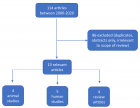
Figure 1
Similar Articles
-
The role of urine metabolomics among newborn infants with hypoxic ishaemic encephalopathy: a literature reviewNese Gadzama*,Irfan Ahmed,Sundus Khursheed,Niazy AL-Assaf,Rizwan Khan. The role of urine metabolomics among newborn infants with hypoxic ishaemic encephalopathy: a literature review. . 2021 doi: 10.29328/journal.japch.1001042; 4: 109-113
Recently Viewed
-
Maternal and perinatal outcomes of uterine rupture in Lubumbashi, Democratic Republic of CongoJacques Ngoy Kitenge,Olivier Mukuku*,Xavier K Kinenkinda,Prosper L Kakudji. Maternal and perinatal outcomes of uterine rupture in Lubumbashi, Democratic Republic of Congo. Clin J Obstet Gynecol. 2020: doi: 10.29328/journal.cjog.1001067; 3: 136-141
-
Do Fishes Hallucinate Human Folks?Dinesh R*,Sherry Abraham,Kathiresan K,Susitharan V,Jeyapavithran C,Paul Nathaniel T,Siva Ganesh P. Do Fishes Hallucinate Human Folks?. Arch Food Nutr Sci. 2017: doi: 10.29328/journal.afns.1001003; 1: 020-023
-
Assessment of Redox Patterns at the Transcriptional and Systemic Levels in Newly Diagnosed Acute LeukemiaAna Carolina Agüero Aguilera, María Eugenia Mónaco, Sandra Lazarte, Emilse Ledesma Achem, Natalia Sofía Álvarez Asensio, Magdalena María Terán, Blanca Alicia Issé, Marcela Medina, Cecilia Haro*. Assessment of Redox Patterns at the Transcriptional and Systemic Levels in Newly Diagnosed Acute Leukemia. J Hematol Clin Res. 2024: doi: 10.29328/journal.jhcr.1001029; 8: 017-023
-
Assessment of Indigenous Knowledge on Using of Traditional Medicinal Plants to Cure Human Diseases in South Omo Zone Baka Dawla Ari District, Kure and Bitsmal South EthiopiaGizaw Bejigo*. Assessment of Indigenous Knowledge on Using of Traditional Medicinal Plants to Cure Human Diseases in South Omo Zone Baka Dawla Ari District, Kure and Bitsmal South Ethiopia. J Plant Sci Phytopathol. 2024: doi: 10.29328/journal.jpsp.1001132; 8: 048-054
-
Nanoencapsulated Extracts from Leaves of Bauhinia forficata Link: In vitro Antioxidant, Toxicogenetic, and Hypoglycemic Activity Effects in Streptozotocin-induced Diabetic MiceBárbara Verônica Cardoso de Souza, Alessandra Braga Ribeiro*, Rita de Cássia Meneses Oliveira, Julianne Viana Freire Portela, Ana Amélia de Carvalho Melo Cavalcante, Esmeralda Maria Lustosa Barros, Luís Felipe Lima Matos, Tarsia Giabardo Alves, Maria. Nanoencapsulated Extracts from Leaves of Bauhinia forficata Link: In vitro Antioxidant, Toxicogenetic, and Hypoglycemic Activity Effects in Streptozotocin-induced Diabetic Mice. Arch Pharm Pharma Sci. 2024: doi: 10.29328/journal.apps.1001063; 8: 100-115
Most Viewed
-
Evaluation of Biostimulants Based on Recovered Protein Hydrolysates from Animal By-products as Plant Growth EnhancersH Pérez-Aguilar*, M Lacruz-Asaro, F Arán-Ais. Evaluation of Biostimulants Based on Recovered Protein Hydrolysates from Animal By-products as Plant Growth Enhancers. J Plant Sci Phytopathol. 2023 doi: 10.29328/journal.jpsp.1001104; 7: 042-047
-
Sinonasal Myxoma Extending into the Orbit in a 4-Year Old: A Case PresentationJulian A Purrinos*, Ramzi Younis. Sinonasal Myxoma Extending into the Orbit in a 4-Year Old: A Case Presentation. Arch Case Rep. 2024 doi: 10.29328/journal.acr.1001099; 8: 075-077
-
Feasibility study of magnetic sensing for detecting single-neuron action potentialsDenis Tonini,Kai Wu,Renata Saha,Jian-Ping Wang*. Feasibility study of magnetic sensing for detecting single-neuron action potentials. Ann Biomed Sci Eng. 2022 doi: 10.29328/journal.abse.1001018; 6: 019-029
-
Pediatric Dysgerminoma: Unveiling a Rare Ovarian TumorFaten Limaiem*, Khalil Saffar, Ahmed Halouani. Pediatric Dysgerminoma: Unveiling a Rare Ovarian Tumor. Arch Case Rep. 2024 doi: 10.29328/journal.acr.1001087; 8: 010-013
-
Physical activity can change the physiological and psychological circumstances during COVID-19 pandemic: A narrative reviewKhashayar Maroufi*. Physical activity can change the physiological and psychological circumstances during COVID-19 pandemic: A narrative review. J Sports Med Ther. 2021 doi: 10.29328/journal.jsmt.1001051; 6: 001-007

HSPI: We're glad you're here. Please click "create a new Query" if you are a new visitor to our website and need further information from us.
If you are already a member of our network and need to keep track of any developments regarding a question you have already submitted, click "take me to my Query."






